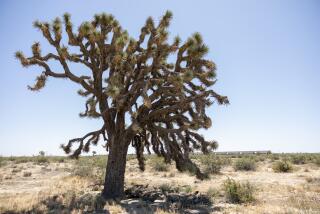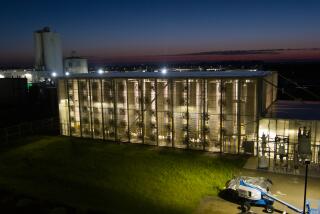California ski resorts embrace renewable energy and hope skiers will love it

In the peaks near Lake Tahoe, the Squaw Valley and Alpine Meadows ski resorts are hoping to draw skiers and snowboarders with some upgrades that have nothing to do with snow.
The two resorts, owned by the same Colorado parent company, plan to become the country’s first resorts to operate entirely on renewable energy by December. Squaw Valley also plans to build a mountain-side structure that will contain batteries to store some of that energy.
For the record:
12:00 a.m. Feb. 10, 2018An earlier version of this story misspelled the name of Michael Reitzell.
“Squaw Valley is usually at the forefront of all of these issues,” said Michael Reitzell, president of the California Ski Industry Assn., a trade group that represents the state’s ski resorts.
Other California ski operations also are becoming more environmentally friendly.
Last year, another Tahoe-area resort, Boreal Mountain, installed 715 solar panels on the roof of its indoor sports facility on the base of the resort’s mountain. About two miles away, the Soda Springs ski resort began using 100% recycled water in 2015 for all of its snow-making efforts.
Vail Resorts — the Colorado company that owns 11 ski resorts, including Heavenly, Northstar and Kirkwood in California — has vowed to eliminate all emissions and waste sent to landfills for the entire company by 2030.
“We believe climate change is one of the most significant challenges facing every country, every business and every person on our planet, and we all have a shared responsibility to address it,” said Beth Ganz, Vail Resorts’ vice president of public affairs and sustainability.
Ski resort operators say there is a sound business reason behind such efforts. Not only do the resorts expect to save money over the long run by turning to renewable energy and cutting waste, but they also hope to appeal to skiers — particularly millennials — who put a premium on environmentally friendly travel destinations.
“They are going to support brands that they see a piece of themselves in,” said Laura Schaffer, a spokeswoman for Powdr, the Utah parent company of the Boreal and Soda Springs ski resorts.
A 2016 study sponsored by Visit California, the tourism agency for the state, found that 63% of travelers say they are much more likely to consider visiting destinations where there is a strong effort to conserve and protect natural resources.
At Boreal, 78% of the 250 guests who were questioned said environmental sustainability is important to them.
But some local skiers say other factors — location, price and snow quality — are more important in helping them decide where to ski.
“Everybody is for renewable energy” said Richard Murray, president of the Conejo Ski & Sports Club, which organizes regular visits to Mammoth Mountain in the Eastern Sierra, Sun Valley resort in Idaho and Aspen Snowmass in Colorado. “It’s a good thing, but we wouldn’t make a decision based on that.”
Bruce Lee, president of the Beach Cities Ski Club in Hermosa Beach, also said other factors, such as snow conditions, play a bigger role in deciding where the ski.
“I’m looking at the resort and the resort’s amenities,” he said. “I’m not sure [renewable energy] swings me to go to one place over another.”
None of the resorts that have adopted the renewable energy projects are promising to lower ski lift prices as a result.
Renewable energy is not always cheaper than the power offered by traditional utility companies because power rates can vary depending on the price of the coal, natural gas and other resources used by traditional utility companies.
But Sara Baldwin Auck, director of regulatory programs for the nonprofit Interstate Renewable Energy Council, said renewable energy can be cheaper and less volatile in price over the long run than traditional energy.
“By locking in long-term renewable energy contracts and a dedicated set of facilities over time, they definitely will be reaping long-term savings,” she said.
Boreal says the solar panels it has installed are expected to save $1.5 million in energy costs over 30 years.
To convert to renewable energy, Squaw Valley and Alpine Meadows have teamed up with Liberty Utilities Co., the electricity provider for the Lake Tahoe area. The company delivers water, natural gas and electricity in 12 states.
Liberty now generates 25% of its energy from renewable sources and says it plans to develop “a series of projects,” primarily involving solar power facilities, to achieve the 100% goal.
Squaw Valley is also working with Liberty Utilities to build a power storage “microgrid” facility on the slope to store some of the energy produced by Liberty.
The power company is talking to Tesla, the Elon Musk-led company, to develop the power storage project, which still needs the approval of state and local regulators.
The batteries would store electricity when demand is low and discharge the power when demand is high or in the event of a power outage.
At Squaw Valley, the power storage facility is intended to supply energy for the entire Olympic Valley, an unincorporated community that includes the ski resort. Skiers on the slope may benefit when the storage facility is switched on during power outages that would otherwise strand skiers on disabled lifts.
To read more about the travel and tourism industries, follow @hugomartin on Twitter.
More to Read
Inside the business of entertainment
The Wide Shot brings you news, analysis and insights on everything from streaming wars to production — and what it all means for the future.
You may occasionally receive promotional content from the Los Angeles Times.











